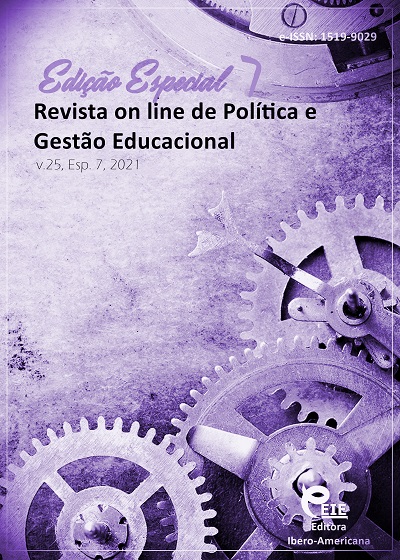Hacia un modelo multinivel de educación profesional y técnica continua
DOI:
https://doi.org/10.22633/rpge.v25iesp.7.16149Palabras clave:
Asignaturas académicas fundamentales, Asignaturas generales de ingeniería, Orientación profesional, Modelo metodológicoResumen
El propósito del estudio es diseñar un sistema científico y metodológico dirigido a profesionales. El diseño de la estructura y el contenido de las asignaturas académicas fundamentales se realiza a partir del ejemplo de la física, que son básicos en la formación de ingenieros: electricistas, ingenieros de potencia, electromecánica y electrónica. Para el diseño de la estructura de planificación de la formación, se eligieron los siguientes métodos de investigación: orientación profesional de la formación, cuando el núcleo formador del sistema de formación es la dirección de la formación, la futura especialidad; Principio de relación integradora de todas las asignaturas académicas educativas entre la definición y protagonismo de las asignaturas académicas especiales o bloque de asignaturas académicas especiales. Al diseñar un sistema científico y metodológico de formación profesionalmente dirigido en materias académicas, se establecen las principales disposiciones conceptuales de un sistema de materias académicas teóricas generales, basado en el modelo diseñado de formación profesionalmente dirigida en materias académicas teóricas generales.
Descargas
Citas
ABDEEV, R. F. Philosophy of information civilization. Moscow, 1994.
BAKHAREV, N. P.; LAVRENINA, A. N. Workshop on solving electrodynamic problems. Togliatti: TolPI, 1999.
BASHISHEVA, S. YA. (Ed.). Professional pedagogy. Moscow: Professional education, 1997. 512 p.
BELYAEVA, A. P. Integration of vocational training. Sov. Pedagogy, 1987.
DAVYDOV, V. V. Types of generalization in teaching (logical and psychological problems of the construction of educational subjects). Moscow: Pedagogy, 1972.
DVOYASHKIN, N. K.; KABIROV, R. R.; NOVIKOVA, A. KH. Forms and methods of teaching a course in general physics in a technical university of oil profile. Humanitarium, v. 2, n. 7, p. 22-25, 2018.
FIRSTOV, D. S. Features of teaching physics (natural science) for managers at an engineering physics university. Physical education in universities, v. 23, n. 2, 74-87, 2017.
GALEEV, I. G.; SHAKIROV, A. S. Some aspects of teaching physics for undergraduate technical students. Science in motion: from reflection to creation of reality. In: GARIFULLINA, M. S. (Ed.). Materials of the all-russian scientific and practical conference. 2016. p. 385-388.
IBATOVA, A. Z. Development of a criteria apparatus for assessing the students' readiness for a dialogue in general and business sphere. Universidad y Sociedad, v. 12, n. 2, p. 48-52. 2020.
KALACHEV, N. V. et al. Practical aspects of increasing the level of knowledge in physics among schoolchildren planning to enroll in technical universities. Modern Physics Practicum, v. 14, p. 25-27, 2016.
KHOLINA, S. A. The concept of an educational and methodological kit on the theory and methods of teaching physics. Pedagogical education and science, v. 5, p. 68-71, 2019.
KORNEV, G. P.; BAKHAREV, N. P.; TAMER, O. S. Methodological features of studying complex numbers based on interdisciplinary connections of mathematics and physics. Special course for professional physical and mathematical training of students of technical universities. Togliatti: TolPI, 1999. cap. 109.
KUSTOV, YU. A.; BAKHAREV, N. P.; VORONIN, V. N. Continuity in the system of continuous education. Textbook. allowance. Togliatti: TolPI, Volga University named after V.N. Tatishcheva, 1999.
LARIONOV, V. V.; VERNIGORA, A. M.; CHERKASOVA, M. A. Cognitive and innovative training of students in teaching physics at a technical university. Bulletin of the Tomsk State Pedagogical University, v. 6, n. 147, p. 60-63, 2014.
MANSUROVA, S. E. Some aspects of teaching a physics course in the magistracy of the Mining University. Modern education: content, technology, quality, v. 1, p. 167-169, 2019.
NECHAEV, N. N. Psychological and pedagogical foundations of the formation of professional activity. Moscow: Publishing house of Moscow State University, p. 166, 1988.
PAK, V. V. Design potential of physical problems and its diagnostics in teaching physics to students of technical universities. Scientific and pedagogical review, v. 2, n. 12, p. 103-107, 2016.
POSTNIKOVA, E. I.; LISICHKO, E. V.; KRAVCHENKO, N. S. Teaching physics at a technical university in the electronic environment MOODLE. Innovative technologies in science and education, v. 2, n. 6, p. 194-198, 2016.
SULTANALIEVA, G. M.; KOSHARNAYA, A. V. Comparative analysis of the system of professional training of specialists in the direction of "Electric power and electrical engineering" in a technical university. Industrial energy, v. 9, p. 52-60, 2020.
TRYNKINA, E. T.; MOKROVITSKAYA, N. V. New approaches to teaching physics and chemistry at a technical university. Training and Upbringing: Methods and Practice of The 2016/2017 Academic Year. In: BLACK-VA, S.S. (Ed.). Collection of materials of the XXXIII International Scientific and Practical Conference. 2017. p. 161-168.
VELIKOVICH, L. L. Physics and Mathematics at a Technical University: Together or Apart. Actual Problems and Prospects of Teaching Mathematics. In: Collection of Scientific Articles of the V International Scientific and Practical Conference. Ministry of Education and Science of the Russian Federation; Southwest State University, 2014. p. 21-32.
VISHNEVSKY, L. I.; ARTYUSHKINA, L. M. Application of logical structures of educational material in teaching physics. Physics at school, v. 1, 1981.
ZAGVYAZINSKY, V. I. Higher school didactics. Lecture text. Chelyabinsk: CPI, 1990.
Publicado
Cómo citar
Número
Sección
Licencia
Derechos de autor 2022 Revista on line de Política e Gestão Educacional

Esta obra está bajo una licencia internacional Creative Commons Atribución-NoComercial-CompartirIgual 4.0.
Manuscritos aceitos e publicados são de propriedade da Revista on line de Política e Gestão Educacional. É vedada a submissão integral ou parcial do manuscrito a qualquer outro periódico. A responsabilidade do conteúdo dos artigos é exclusiva dos autores. É vedada a tradução para outro idioma sem a autorização escrita do Editor ouvida a Comissão Editorial Científica.











